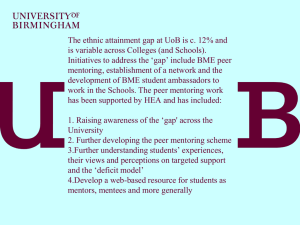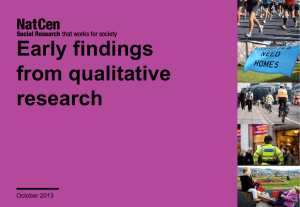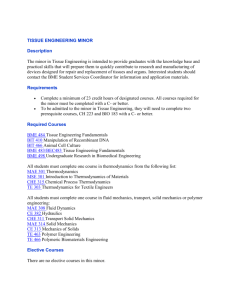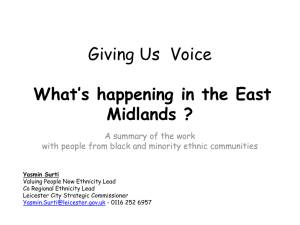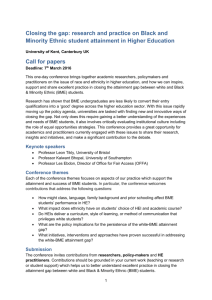Annual Diversity Report 2015 - Hexagon Housing Association
advertisement
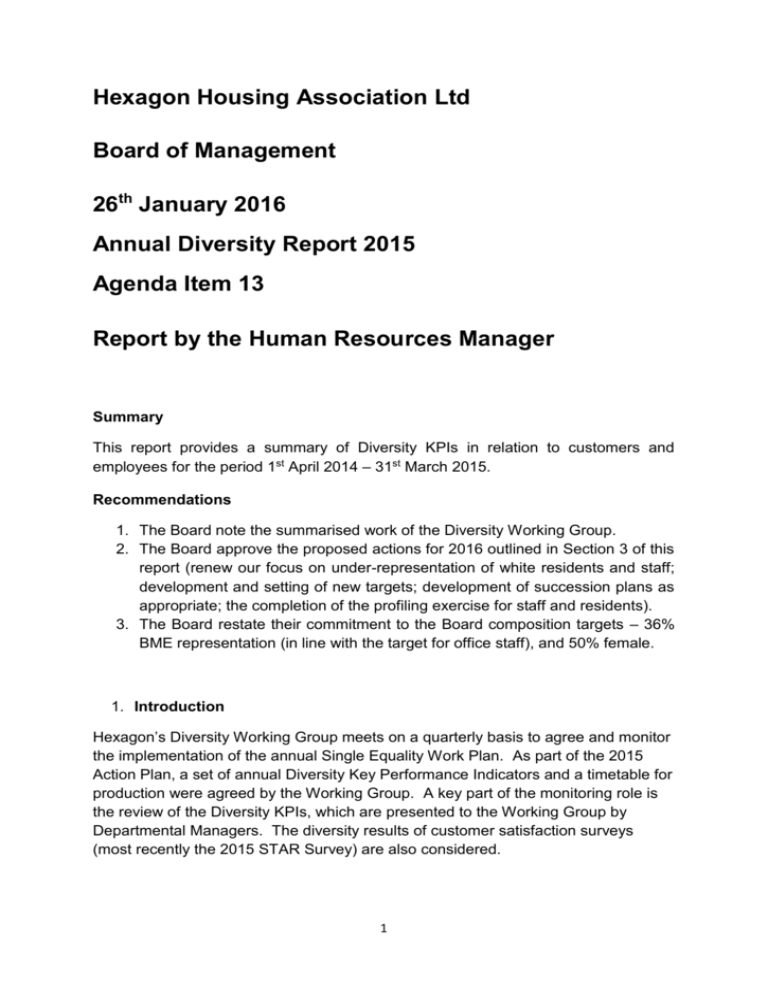
Hexagon Housing Association Ltd Board of Management 26th January 2016 Annual Diversity Report 2015 Agenda Item 13 Report by the Human Resources Manager Summary This report provides a summary of Diversity KPIs in relation to customers and employees for the period 1st April 2014 – 31st March 2015. Recommendations 1. The Board note the summarised work of the Diversity Working Group. 2. The Board approve the proposed actions for 2016 outlined in Section 3 of this report (renew our focus on under-representation of white residents and staff; development and setting of new targets; development of succession plans as appropriate; the completion of the profiling exercise for staff and residents). 3. The Board restate their commitment to the Board composition targets – 36% BME representation (in line with the target for office staff), and 50% female. 1. Introduction Hexagon’s Diversity Working Group meets on a quarterly basis to agree and monitor the implementation of the annual Single Equality Work Plan. As part of the 2015 Action Plan, a set of annual Diversity Key Performance Indicators and a timetable for production were agreed by the Working Group. A key part of the monitoring role is the review of the Diversity KPIs, which are presented to the Working Group by Departmental Managers. The diversity results of customer satisfaction surveys (most recently the 2015 STAR Survey) are also considered. 1 The Diversity Working Group use this information to gain an understanding of the impact our policies and practices may potentially have on people with protected characteristics, and to make recommendations for improvement. It was also agreed in the action plan that a summary of the Diversity KPIs should be presented to the Board in January each year to provide an overview of Hexagon’s progress on promoting diversity and inclusion. This report details a very summarised version of significantly more details reports considered by the Working Group. The intention is to draw out the key strategic matters for the Board to consider that have arisen from this area of our work over the past year. 2. Headline Results This report details a summary of Diversity KPIs in relation to customers and employees for the period 1st April 2014 – 31st March 2015, and the STAR Survey 2015. Lettings o 72% of new general needs lettings were to BME customers. Whilst overall our homes are accessible to a wide range of applicants, we are below target for lettings to White British people in all boroughs (targets range from 32% in Southwark to 63% in Bexley). o New Hexagon tenants are “young” with over 40% coming to us under 32 years old. This is not surprising but is something we need to be aware of when designing and delivering homes and services. o 62% of BME customers and 59% of White British customers rated the general needs lettings quality as excellent. o 74.7% of new lettings were to women. This is caused mainly by family homes being let to single parent families. o 14.1% of those housed has a housing related disability. Community Investment o 83% of residents accessing Community Investment Services were BME, and 67% were female. 2 Resident Involvement 71% of residents participating in Resident Involvement activities are BME, and 43.3% are aged 45-54. Whilst these figures suggest that BME residents are not finding any barriers to their involvement, the Diversity Working Group discussed the issue of the apparent under-representation of involved White British residents. The Resident Involvement Manager has been asked to consider whether alternative mechanisms for involvement could be implemented to encourage wider participation. Customer Satisfaction (STAR Survey) o Lowest customer satisfaction tends to be in the groups that Hexagon has the most general needs tenants – 35 to 44 and 45 to 54 o There is no significant difference in satisfaction levels between BME and White British residents. Employment o The percentage of BME staff is significantly above target in the office (actual BME representation is 59% against a target of 36%), and the care homes (average BME representation is 69% against an average target of 32%).. o 36.2% of staff are in the 45-54 age band, and women represent 66% of the workforce 3. Strategic Matters Arising 3.1 There is a common theme across all of the work areas in relation to the under representation of White British residents accessing Hexagon’s services and employment. This has been highlighted during discussions with the Diversity Working Group, and actions with the aim of seeking to address this issue will be included in the Single Equality Action Plan for the coming year. 3.2 The BME lettings targets were developed several years ago based on Borough waiting list information, and may therefore no longer be accurate. A review of the targets will therefore be undertaken during 2016/17. 3 3.3 There are currently no targets in place for lettings by age, gender or disability, or employment by gender. These targets will be identified over the coming year. 3.4 As the majority of Hexagon’s employees are in the 45-54 age band, likely retirement dates will be closely monitored and any necessary succession plans drawn up to ensure we are prepared for the potential loss of a large amount of knowledge and skills within a relatively condensed period of time 3.5 Another key action is to undertake a comprehensive profiling exercise of residents and employees to include sexual orientation and religion. The aim is to ensure that we tailor our services, and employment policies as far as possible to meet diverse residents’/employees’ needs. Work has already commenced on gathering this information from employees and consideration is currently being given to setting targets in these areas. 3.6 The Board BME and gender targets (38% and 50% respectively), are longstanding and have not been renewed for a number of years. The BME target of 38% was originally set in line with the target for office staff. The existing target for office staff (based on the latest available census information) is 36%. It is therefore proposed that the Board BME target should be amended to reflect this. Further Board diversity targets will be revisited following completion of the work on staff and customer profiling. Tracy Inniss 18th January 2016 4

